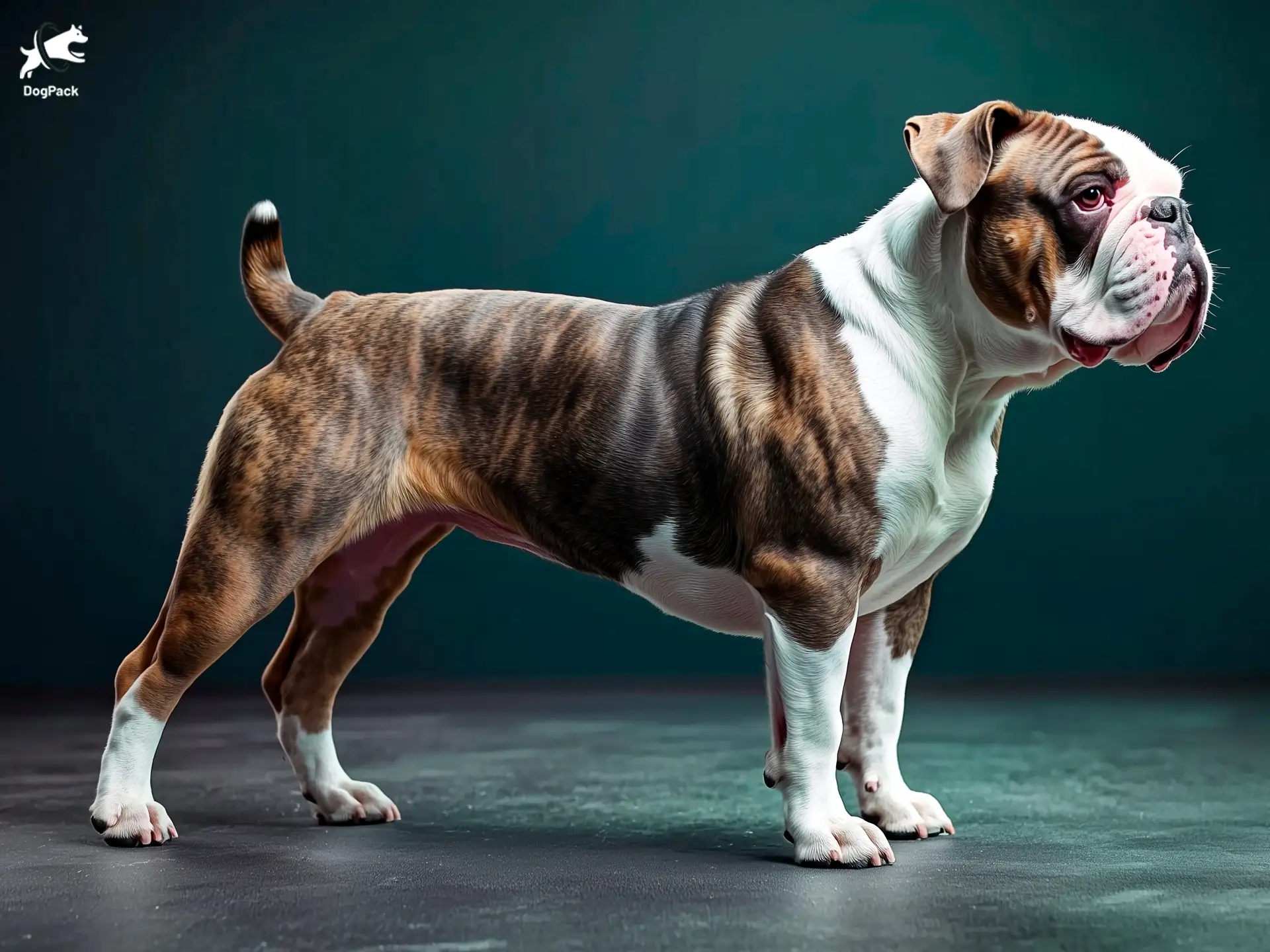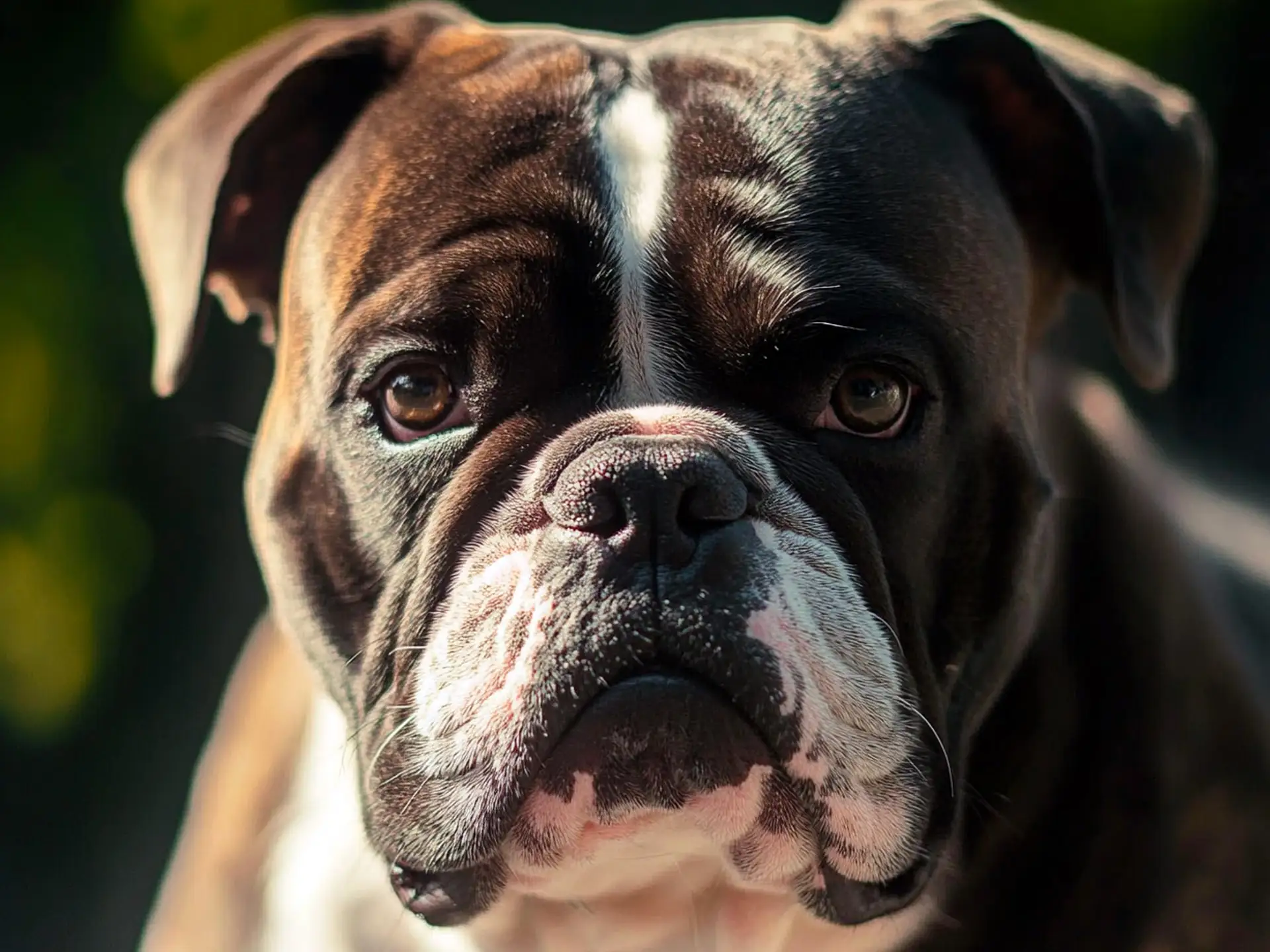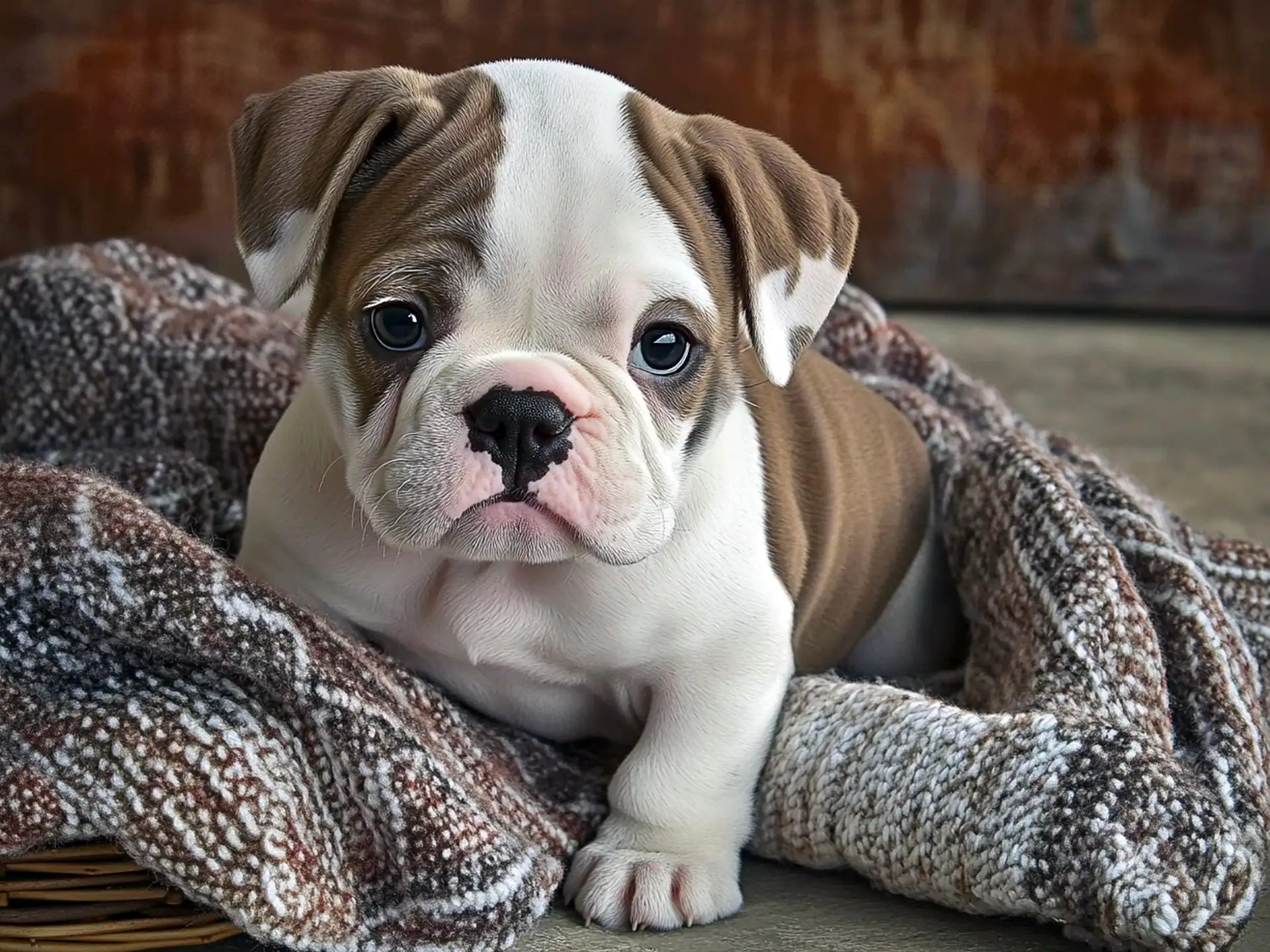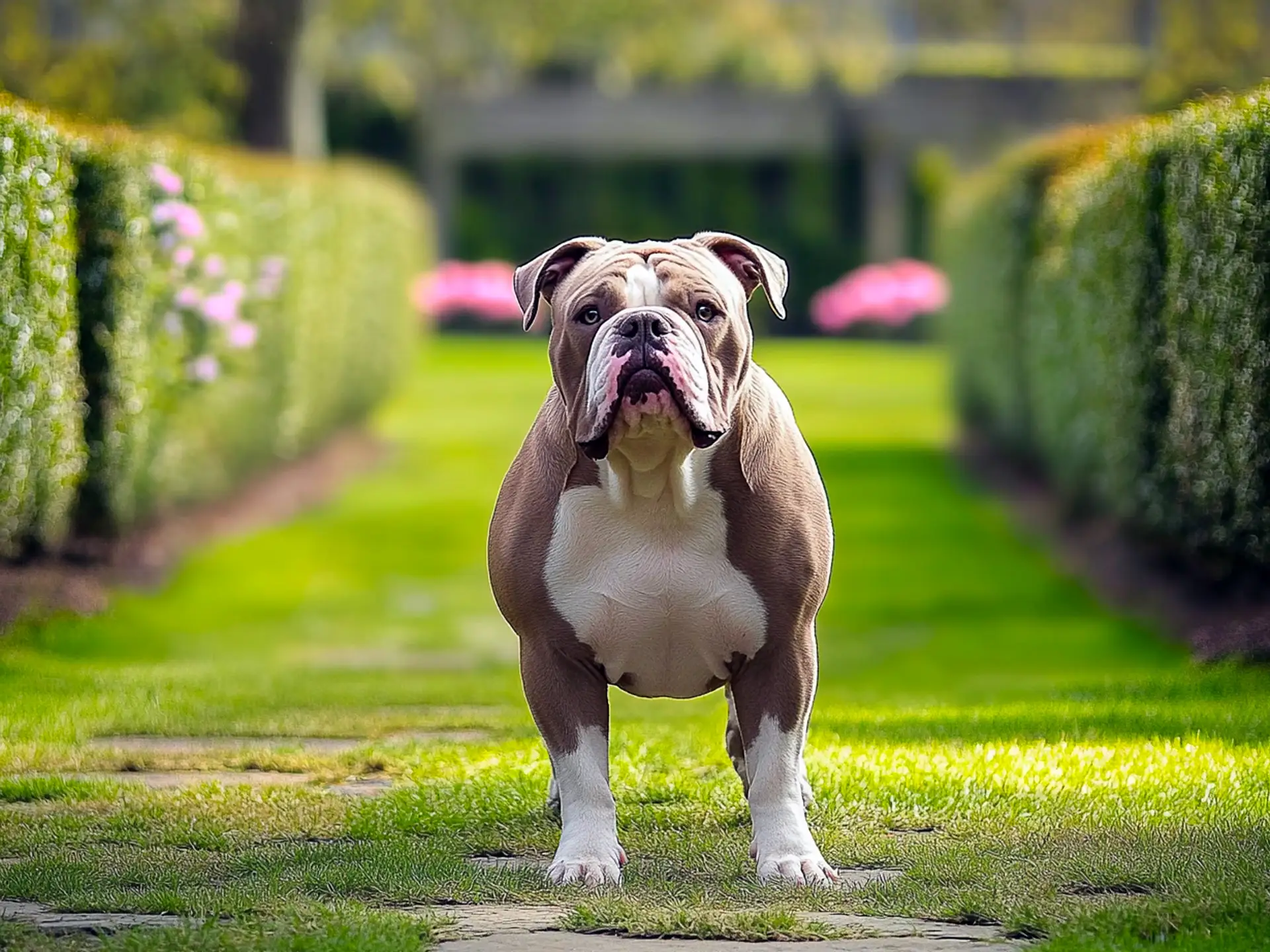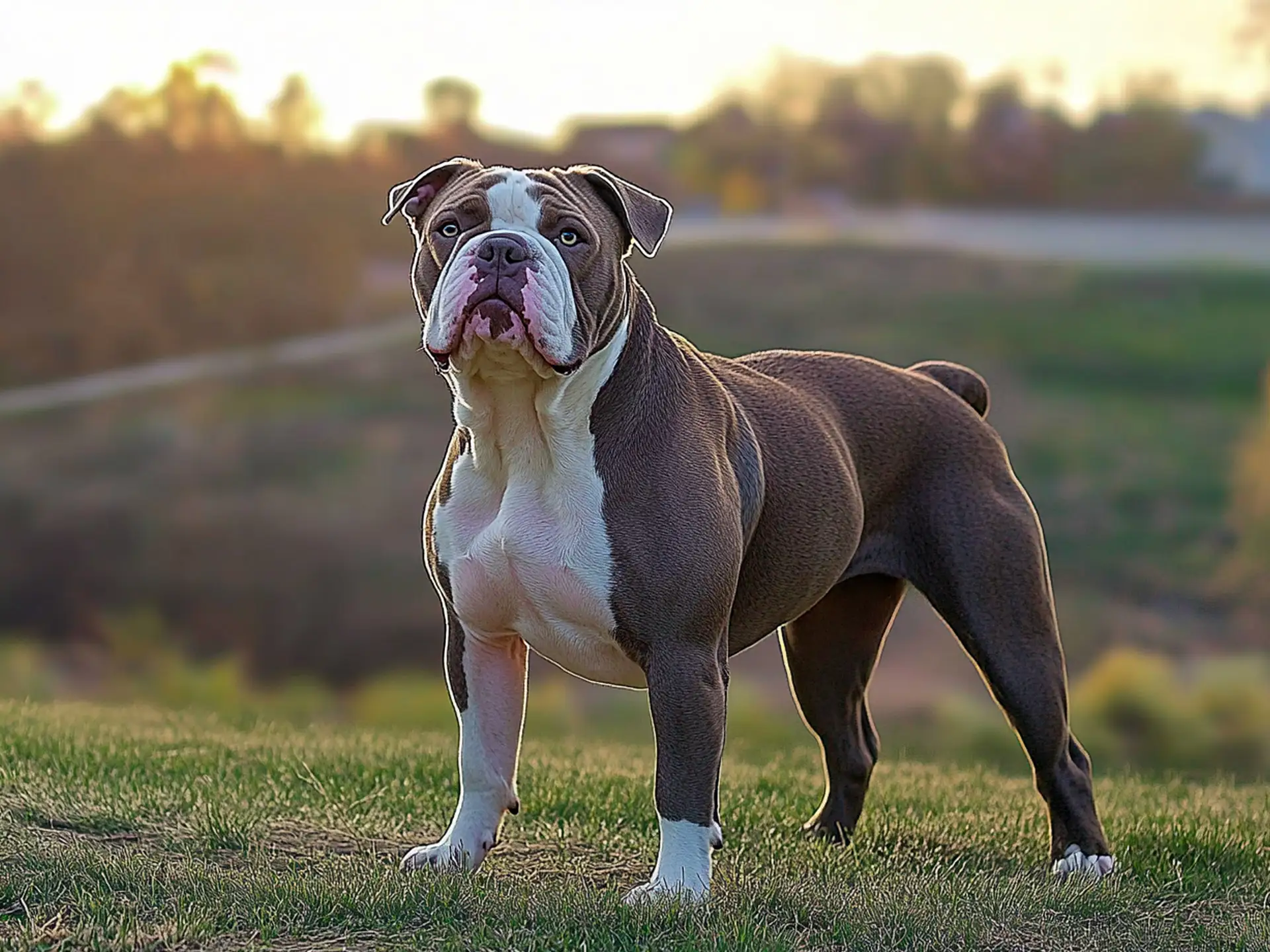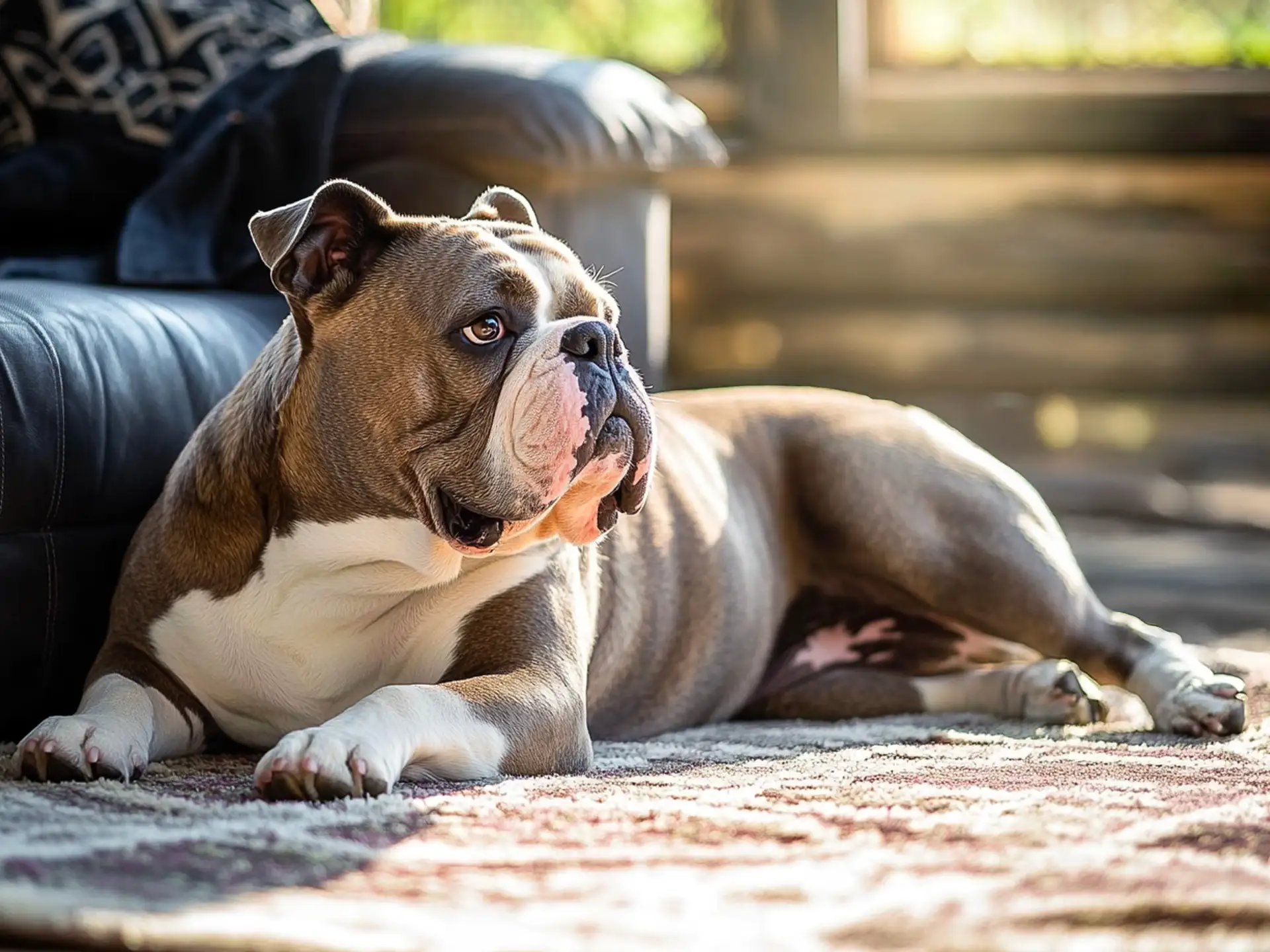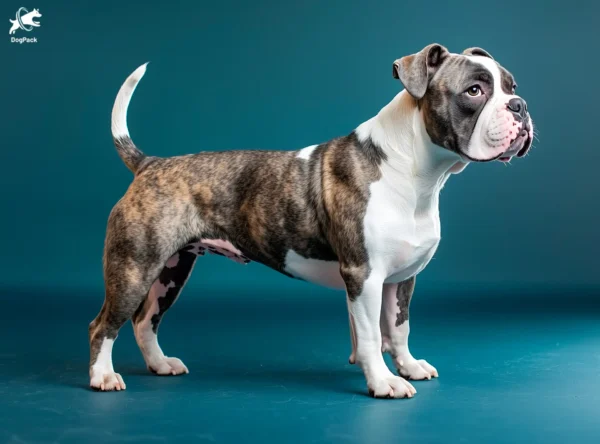Olde English Bulldogge Dog Breed Info & Overview
The Olde English Bulldogge is a modern recreation of the original 18th-century Bulldog—minus the health issues. Bred for strength, stamina, and stability, this athletic breed combines the muscular physique of its ancestors with a gentler, more companionable nature. Loyal and courageous without being aggressive, the Olde English Bulldogge is a balanced, confident dog suited for active families.
Characteristics
Old English Bulldog vs Olde English Bulldogge – Key Differences
| Feature | Old English Bulldog (Extinct) | Olde English Bulldogge (Modern Breed) |
|---|---|---|
| Origins | England (17th–19th century) | U.S. (1970s, recreation) |
| Purpose | Bull-baiting | Companion, working dog |
| Size | Medium, muscular | Larger, athletic |
| Temperament | Aggressive, fighter | Loyal, confident, stable |
| Health Issues | Unknown (extinct) | Fewer issues than English Bulldogs |
Pictures
Breed History
The Olde English Bulldogge came to life in the 1970s when American breeder David Leavitt aimed to recreate the healthier, more athletic Bulldog of yesteryear. Inspired by the now-extinct Old English Bulldog, Leavitt combined several breeds—English Bulldog, Bullmastiff, American Pit Bull Terrier, and American Bulldog—to reduce health problems and restore physical prowess.
This purposeful blend captured the robust spirit of historical Bulldogs while avoiding extreme brachycephalic traits. Unlike the modern English Bulldog, these dogs featured longer muzzles, allowing better breathing. Over time, enthusiasts formed dedicated clubs to preserve the Olde English Bulldogge’s distinct characteristics. Though still considered a “rare” breed, they’ve steadily gained fans who value a more functional, agile Bulldog.
In 2014, the UKC officially recognized the Olde English Bulldogge, but it remains unrecognized by the AKC and FCI. Today, breeders continue refining these dogs for stable temperaments and solid health. Their story stands as an example of how selective crossbreeding can revive classic canine traits while accommodating modern expectations, proving that heritage and well-being can coexist in one remarkable breed.
Temperament, Personality
When you first meet an Olde English Bulldogge, you’ll notice a confident and protective demeanor. Thanks to their working roots, they remain vigilant yet can be surprisingly gentle with loved ones. Early socialization cultivates a calm, reliable pet rather than an overbearing guardian. This balance of watchfulness and easygoing charm is a testament to thoughtful breeding.
While they maintain a classic Bulldog tenacity, they’re notably less aggressive than their bull-baiting predecessors. Many owners praise them for being playful and eager to form strong family bonds. Still, they can be wary of strangers or large unfamiliar animals, making structured introductions essential. If you’re a consistent leader, this breed will reward you with unwavering loyalty and a mellow disposition at home.
One hallmark of the Olde English Bulldogge is emotional stability. They’re not usually prone to the stubborn streak seen in some bully breeds, although firm guidance helps them thrive. Their self-assured attitude can come off as aloof if they’re not raised to be sociable. Overall, these dogs fuse the best of both worlds: an imposing presence combined with a friendly, even temperament when properly nurtured.
Physical Characteristics
Athletic build and a sturdy frame set the Olde English Bulldogge apart from many modern Bulldogs. With a broader skull than the American Bulldog and a slightly longer muzzle than the English Bulldog, they’re built to breathe more efficiently. A thick, muscular neck transitions into well-defined shoulders and a barrel chest, reflecting the breed’s working heritage.
Despite their robust stature, they’re surprisingly agile. They often sport a slightly curved tail—sometimes docked—but natural tails are common. The breed’s coat remains short and smooth, coming in various colors like brindle, white, fawn, or black. A moderate underbite is typical, but it’s not as pronounced as in many brachycephalic breeds, further helping them avoid respiratory complications.
Their medium-to-large size suits owners looking for a sturdy, eye-catching dog without the extreme bulkiness seen in some Bulldogs. Standing up to 20 inches tall, these dogs generally weigh between 50 and 80 pounds, putting them in the realm of strong, athletic companions. The Olde English Bulldogge’s powerful look serves as a reminder of the original Bulldog’s legacy, balanced by modern improvements for comfort and longevity.
Health Issues
One of the breed’s primary goals was improved health over the English Bulldog. The Olde English Bulldogge usually experiences fewer breathing difficulties thanks to a longer snout. However, no breed is entirely free of issues. Potential concerns include hip and elbow dysplasia, allergies, and certain eye conditions. Regular checkups can help catch problems early.
Genetic screening by reputable breeders reduces the likelihood of inherited diseases. X-rays for joint health, for example, aid in identifying dysplasia risk. These dogs also benefit from a balanced diet and consistent exercise to stave off obesity, which can exacerbate joint problems. Observing your dog’s movements, appetite, and overall demeanor offers early clues about any emerging health challenges.
Breathing issues, though much less severe than in some bulldog types, might still arise in extremely hot weather or with excessive exertion. Watch for signs of distress such as loud snoring or labored breathing. With mindful care, most Olde English Bulldogges enjoy a robust life. Emphasizing responsible breeding and routine veterinary care will help maintain the breed’s reputation for better health compared to its ancestors.
Grooming Needs
This breed’s short coat is straightforward to maintain. Weekly brushing with a soft-bristle brush or grooming mitt helps remove loose hairs and dead skin. Not only does this minimize shedding, but it also encourages bonding time. Their coat naturally repels dirt, so frequent baths aren’t usually necessary—every month or two often suffices unless your dog gets especially grimy.
Pay special attention to wrinkles or folds if they’re pronounced. Gently cleaning and drying these areas can prevent bacterial infections. Ears should be checked weekly for wax buildup and debris, especially if your Bulldogge romps around outdoors. Nail trimming is important to avoid overgrowth, which can alter posture and cause discomfort.
Most Olde English Bulldogges don’t carry a strong doggy odor, so routine coat care is relatively low-effort. Use a mild shampoo when bathing to avoid drying out their skin. You may also want to wipe around the mouth after meals to keep drool at bay. Overall, grooming requirements are moderate, making them manageable for owners seeking a fuss-free routine.
Exercise Requirements
Although less hyper than some athletic breeds, the Olde English Bulldogge still needs regular physical activity. One or two brisk walks per day, combined with active play sessions, usually keeps them fit. Many enjoy short runs, flirt-pole activities, and even canine sports like weight pulling, provided you build up their stamina properly.
Their muscular build means they thrive with interactive games. Tug-of-war, fetch, or obstacle courses can engage both body and mind. Don’t underestimate their energy just because they’re bulldog-based. They can become bored and destructive if left idle. Owners who appreciate an energetic companion will find them eager to please, as long as exercise is fun and varied.
Monitor activity in hot climates; brachycephalic tendencies mean overheating is still possible, though not as severe as in some Bulldogs. Early morning or late evening walks help avoid midday heat. Keep hydration accessible and watch for signs of exhaustion. With balanced exercise, the Olde English Bulldogge stays healthy, mentally engaged, and far less prone to weight gain or restlessness.
Training Tips
The Olde English Bulldogge responds best to firm, consistent instruction that respects their intelligence. Positive reinforcement with treats or praise keeps them motivated. Harsh techniques risk stubbornness or fearfulness, so a calm, authoritative approach yields better results. Patience is crucial—while eager to bond, they may challenge owners if boundaries aren’t clear.
Socialization from puppyhood can head off territorial behaviors. Gradual introductions to new people, pets, and environments build confidence. It’s wise to practice handling drills—touching paws, ears, and mouth gently—so grooming and vet checkups stay stress-free. Short, engaging sessions cater to their bulldog-like attention span and maintain training momentum.
Basic obedience lays a solid foundation, and advanced tasks help prevent boredom. Teaching commands like “stay,” “leave it,” or “quiet” can be especially beneficial, given this breed’s protective nature. Consider enrolling in structured obedience classes or advanced courses for an added challenge. With the Olde English Bulldogge’s loyal streak, training done right fosters a rewarding human-canine partnership.
Nutrition, Diet
Feeding the Olde English Bulldogge requires a high-quality diet that supports muscle maintenance and joint health. Lean proteins like chicken, turkey, or fish are ideal bases. Look for formulas tailored to moderately active large-breed dogs, emphasizing balanced calcium-phosphorus ratios to protect growing bones. Choose brands free from excessive fillers, which can increase weight gain.
Most adult Olde English Bulldogges do well on about 2 to 3 cups of premium kibble per day, split into two meals. Opt for a brand containing glucosamine, as it may benefit their hips and elbows. Some owners supplement with fish oil for skin and coat support. Monitor your dog’s physique to adjust portions, especially if they engage in intense exercise or have lower activity.
Since this breed’s ancestors included Bulldogs prone to obesity, portion control is key. Treats should be used strategically—too many can lead to extra pounds and stress on joints. Fresh water must be available, especially post-exercise. Any transition to new foods should be gradual, mixing in small increments to avoid stomach upsets. With the right diet, the Olde English Bulldogge stays lean, strong, and lively.
Adoption, Breeders
Seeking an Olde English Bulldogge? Reputable breeders focus on temperamental stability and solid health testing. Ask about genetic screenings for hip and elbow dysplasia, as well as family history of skin or eye issues. Adopting from a rescue specializing in bulldog breeds is another route—some organizations occasionally have Olde English Bulldogges looking for homes.
Check official resources like the International Olde English Bulldogge Association (IOEBA) or the Olde English Bulldogge Kennel Club for breeder referrals and in-depth breed standards. While these dogs remain relatively rare, you’ll find dedicated enthusiasts committed to preserving their hallmark blend of athleticism and approachable temperament.
Before committing, confirm puppies were raised with early socialization and consistent human interaction. Steer clear of breeders unwilling to answer questions about lineage or health tests. Patience pays off—finding a trustworthy source ensures you welcome a well-bred Olde English Bulldogge into your life. Once the right pup or rescued adult joins your family, you’ll see why fans rave about their energy and heart.
Family Pet?
Because it’s more athletic and balanced than some other bulldog types, the Olde English Bulldogge can fit nicely into family settings. They’re typically patient with respectful kids, though supervision is wise given their size. With ongoing training, they learn to handle new environments calmly, reducing the risk of boisterous behavior.
Families with older children may find this breed’s playful nature charming. Younger kids need guidance on appropriate interactions, as an excited Bulldogge might knock someone over accidentally. Introductions to other pets should be planned and gradual. Despite a protective streak, with proper socialization they can coexist peacefully with other animals.
This breed thrives on companionship, so isolation can lead to boredom or destructive habits. They love being part of daily family routines, from outdoor playtime to relaxed evenings at home. An Olde English Bulldogge that’s included in household activities becomes a devoted family member, showcasing loyalty and good manners when consistently guided.
Right For You?
If you admire the toughness of bulldogs but want fewer health woes, the Olde English Bulldogge might catch your eye. This modern breed’s athleticism and friendly demeanor strike a balance between protective watchdog and loving pet. They do well with owners committed to exercise and structured training.
You’ll need enough space for a powerful, energetic companion, although they aren’t hyper. A backyard or nearby park for daily walks and playtime is beneficial. Be prepared to offer consistent leadership—these dogs respect a confident alpha. If you appreciate a loyal sidekick that’s part nostalgia, part modern vigor, you’ll likely enjoy this breed.
Ultimately, the Olde English Bulldogge is best for individuals or families who can match its moderate exercise needs and value a guardian that also doubles as a laid-back buddy. Owners who research bloodlines carefully and invest in quality care will find a steadfast, affectionate canine. If you seek a strong yet warmhearted dog, consider making an Olde English Bulldogge part of your life.
Conclusion
The Olde English Bulldogge embodies a thoughtful return to the Bulldog’s origins—powerful yet healthier, protective yet balanced. By blending key traits from several breeds, dedicated enthusiasts revived a dog that pairs athletic prowess with an amiable nature. While not officially recognized by every kennel club, this distinctive Bulldog variety has carved its own niche among those desiring a robust, loyal companion. If you’re seeking a breed that honors tradition but embraces modern wellness, the Olde English Bulldogge might be your perfect match.
FAQs
-
What makes the Olde English Bulldogge different from the English Bulldog?
The Olde English Bulldogge is more athletic, healthier, and less brachycephalic than the English Bulldog. Bred to resemble 18th-century Bulldogs, it has fewer breathing issues, a longer muzzle, and a stronger build, making it more suitable for active lifestyles.
-
Is the Olde English Bulldogge recognized by major kennel clubs?
The Olde English Bulldogge is not recognized by the AKC or FCI, but it is recognized by the UKC (United Kennel Club) as a distinct modern breed. It’s also registered with several rare breed organizations and performance-based registries in the U.S.
-
Why was the Olde English Bulldogge developed in the 1970s?
The Olde English Bulldogge was created by David Leavitt to recreate the athleticism and health of the original Old English Bulldog, but with a more stable temperament. The goal was to produce a family-friendly, working-capable dog free from the severe health issues of modern Bulldogs.
-
What breeds were used to create the Olde English Bulldogge?
The Olde English Bulldogge is a mix of English Bulldog, Bullmastiff, American Bulldog, and American Pit Bull Terrier. This blend was chosen to create a strong, healthy, and confident dog with fewer inherited issues and improved physical function.
-
Can Olde English Bulldogges compete in dog sports?
Yes, the Olde English Bulldogge excels in weight pulling, obedience, protection work, and agility. Their muscular build, endurance, and drive make them well-suited for active roles beyond companionship, especially when trained from a young age.
Breed Ratings
The Olde English Bulldogge shows quick learning ability, especially with patient training and positive reinforcement.
They enjoy interactive games and can be quite boisterous with family members, showcasing a fun-loving side.
Expect daily walks and more vigorous play sessions; they appreciate moderate to high physical activity.
A short coat sheds moderately, but weekly brushing helps keep fur under control.
While not extreme, they might chase small animals if not socialized early, reflecting their working roots.
Minimal coat care and occasional baths suit busy owners looking for low-maintenance grooming.
A firm yet gentle approach is crucial; they’re eager to please but need consistent leadership to shine.
These social dogs can become bored or anxious if left alone for long stretches.
They’re typically quiet, but they will bark to alert owners of strangers or unusual activity.
Moderate drool, especially around mealtime or after exercise, but less than many brachycephalic breeds.
Proper socialization fosters good relations, though some can be wary or dominant toward unfamiliar dogs.
Generally healthier than many bulldog varieties, thanks to careful breeding for fewer respiratory issues.

